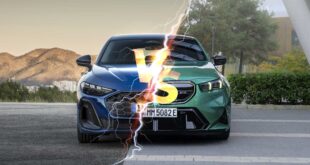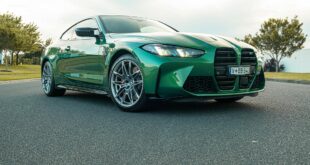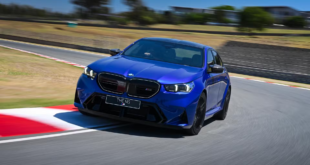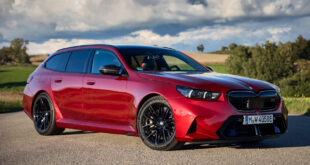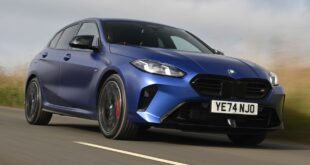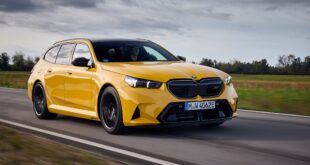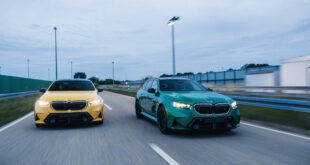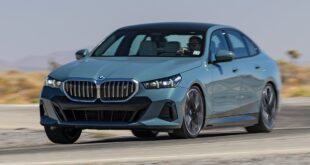World’s first dedicated BMW M dealer restores classic BMW M3 Sport Evolution to its prime.
Singapore. As BMW M GmbH celebrates 40 glorious years since its establishment in 1972, Munich Automobiles – the world’s first dedicated BMW M dealer and authorised BMW Service Centre – pays tribute to this symbolic milestone by restoring the classic 2.5-litre BMW M3 (E30 model) Sport Evolution.
The 6-month project first began in January 2011, and involved the expertise of up to five certified BMW M technicians at Munich Automobiles’ Service Centre.
“Forty great years have passed since BMW M first started its pursuit for speed and performance, and we’ve seen the birth of some legendary cars over these years, namely; the BMW M1 and BMW M3, alongside many other greats,†said Mr Neil Fiorentinos, Managing Director of BMW Group Asia.
“In particular, the BMW M3 was one of the most successful touring cars ever to be built. With an undisputed leadership position in the international touring car scene, it has claimed dual wins in the European Tour Car Championships and German Touring Car Championships (DTM) respectively, as well as many other international events and championships. Further, the first BMW M3 was equally successful as an on-road car for customers with more than 17,970 units sold worldwide,†added Mr Fiorentinos.
“To celebrate this significant milestone of BMW M, Munich Automobiles has embarked on a restoration project to bring the ultra-rare 2.5-litre BMW M3 (E30 model) Sport Evolution back to its former glory. Apart from being the first BMW M3 ever built in history, it is also a revolutionary symbol that saw the union between sporting performance and environmental protection. Additionally, the 2.5-litre BMW M3 Sport Evolution holds a special position in the hearts of petrolheads alike, with only 600 units of it around the world. Therefore, we couldn’t have found a more apt BMW M model to commence this restoration project on,†said Mr Joel Chang, Executive Director of Munich Automobiles Pte Ltd.
“Through this project, we also hope to demonstrate the skilled hands of our certified BMW M technicians and the capabilities of our aftersales workshop which not only services BMW M cars, but regular BMW vehicles as well,†concluded Mr Chang.
World premiere at the Frankfurt Motor Show in 1985.
On the BMW exhibition stand at the Frankfurt Motor Show in autumn 1985, the BMW M3 was presented to a more broadly based public audience for the first time. Even without a special paint finish, it was not difficult to distinguish the car from the other BMW 3 Series vehicles. The boot lid was crowned by a spoiler across the width of the car. Aprons all round indicated the refined aerodynamic work that had been carried out on the body. The C-pillar of the BMW M3 was slightly wider than that of the series model and had a flatter taper in order not to interrupt the airflow over the edge of the roof and at the same time direct it more effectively onto the rear spoiler. Thick cheeks had sprouted over the wide wheels of the M3, with the flared wheel arches coming to an end in a striking lip below the edges of the wings. There was no question about it – the BMW M3 looked fast even when it was perched on an exhibition stand.
However, test drivers and customers alike had to be patient for at least another six months. In spring 1986, the first pilot-production cars were ready and the M3 was launched to a press audience – appropriately on the racing track at Mugello. The test drivers established that the aerodynamic profile of the M3 was an understatement rather than an overstatement – impressive high-quality racing technology was housed under the beefy bodywork. Axle kinematics, suspension and damping had changed. The braking system with ABS as standard comprised inner-vented brake discs with ventilation at the front and a high-pressure pump operated by the engine.
This servo pump delivered power to the steering at the same time so that both systems were able to operate independently of the negative pressure of the engine.
The BMW M3 weighed in at just 1,200 kilograms without payload on the scales and hence remained a sporty lightweight. The weight-to-power ratio at only 6.15 kilograms for every 1 hp was an extremely impressive figure even by today’s standards. This was primarily due to the use of plastic components. Although the bodywork including the wide wheel housings were made of metal in keeping with tradition, the front and rear bumpers, and side sills, boot lid and spoilers were made of plastic.
235 km/h top speed for 58,000 marks.
The refined aerodynamic work paid off with an outstanding cW value of 0.33. The lift at the front axle was around half that of the other two-door 3 Series models. The large rear wing reduced the lift on the rear axle by some two thirds. This was evident to the driver in the form of significantly increased driving stability and more precise steering characteristics at very high speeds. In fact, the standard M3 reached a top speed of 230 km/h with catalytic converter and 235 km/h without catalytic converter. And yet it was relatively fuel-efficient for super. Using the then current Euromix formula for super made up of Speed 80, 120 and town cycle, the M3 consumed significantly less than nine litres for every 100 km/h driven. However, the power pack came at a price: an M3 cost 58,000 marks when it was launched in 1986. By comparison, the 325i convertible at 43,300 marks was the next car down the BMW 3 Series price list.
Nevertheless, finding customers for the requisite volume of 5,000 vehicles simply wasn’t a problem. In the summer of 1986 – long before delivery started – purchase contracts for the M3 were being offered on the relevant advertisement pages at a premium price. In actual fact, it wasn’t until 1987 that all 5,000 units of the first M3 were gathered on the BMW parking lot in Munich-Freimann for a family photo before being shipped all over the world.
Roberto Ravaglia in a BMW M3: first and last World Touring Car Champion.
The first race for the 1987 World Touring Car Championship started in Monza on 22 March 1987 – and ended with a sensation. All the M3 cars were excluded from the placings. The vehicles were checked under chaotic conditions and disqualified because of sheet-metal thicknesses that were allegedly contrary to the regulations. BMW appealed but the sports tribunal decided that the appeal had been lodged too late. There was no longer any talk of infringements of the rules. The entire gaffe naturally didn’t have any effect on the result of the championship. At the end of the season, Roberto Ravaglia was standing on the podium as the first World Touring Car Champion. But that was only the pinnacle of the success list.
Wilfried Vogt took the title of European Champion. Altfried Heger came in second – both driving a BMW M3. Eric van de Poele won the prestigious German Touring Car Championship. Moreover, the most sporty 3 Series car was also winning competitions off the race track. An M3 crossed the finishing line in first place in the Corsica Rally and secured a victory for BMW after a gap of 14 years in a race for the World Rally Championship.
“Sportiest saloon of the yearâ€.
The well-informed public rewarded the success story of the newcomer when readers of racing magazine sport auto voted the M3 “the sportiest saloon of the yearâ€. The high-profile 3 Series also became increasingly exciting in its civilian version. In 1987, it was equipped with electronically adjustable shock absorbers. Drivers had a knob beside the handbrake lever which allowed them to choose between the adjustments sport, normal and comfort. Control lamps on the instrument panel displayed the setting that had been selected.
The resilience of the four-cylinder under tough operating conditions on the race tracks rewarded private customers with two very special offers in 1988. BMW created an exclusive special series of even more powerful M3 cars with the suffix “Evo†for Evolution. Identifiable by even more opulent spoilers, this special M3 was powered by a 220 hp engine, while the ‘cat’ version of the standard M3 generated 215 hp. The second package was intended for a very special circle of customers: an open M3 based on the 3 Series Convertible. The 215 hp convertible had a top speed of 239km/h and was by far the fastest open-top four-seater to be bought in a limited series.
24 Hour Race: M3 double victory on the Nürburgring.
In the meantime, the BMW M3 was really getting going on the race track. The two-door car didn’t just win the German Touring Car Championship. It also took the national titles in France, England and Italy. In the following year, the BMW racing car was equally difficult to beat. The M3 packing 300 bhp beat its touring-car competitors in Germany, Belgium, Holland, France, Italy, Finland, Spain, Sweden and Yugoslavia hands down. Belgian Marc Duez battled through the Monte Carlo Rally with an M3 and took eighth place as best driver in a car without four-wheel drive. Altfried Heger and Roberto Ravaglia crowned the success story with a sensational twin victory at the 24 Hour Race on the Nürburgring.
Specials: Sport Evo.
The M3 had a commanding presence on the international touring car racing scene for five years. It became the most successful touring car of all times by winning the champion’s title several times in the European Touring Car Championship and twice in the German Touring Car Championship. There were also numerous further victories and championship wins at international level. Depending on the competition rules, the four-valve engine had to be adapted to national regulations. For example, the capacity for England was limited to 2 litres while for Germany and France it was raised to 2.5 litres with effect from 1990. This enabled the four cylinder to deliver up to 360 bhp. Depending on the version and the deployment profile, engine and mixture management also varied. Air intake was managed by independent throttle valves and valve control systems. In the version with the biggest capacity, the engineers of BMW M GmbH went up against the limits of what was feasible. In order to make full use of the 2.5 litre limit, they not only increased the stroke of the 2.3 litre unit from 84 to 87 millimetres, but also increased the bores of the four cylinders from 93.4 millimetres each to 95.5 millimetres. This reduced the width between the cylinders to just 4.5 millimetres. But success proved the development engineers right. The engines withstood the stresses and strains of touring-car racing even at maximum output without any problem.
A civilian version of this original M3 with the biggest capacity drove onto the roads with the additional name of Sport Evolution. Its characteristic feature was the two-tier rear wing. This 238 hp sports car was limited to 600 units.
By the end of 1991, 17,970 BMW M3 cars of the first generation had left the manufacturing facility, including the 600 units of BMW M3 Sport Evolution. Nobody had anticipated this overwhelming success, either on the road or on the racing circuit. Continuing this success was an obvious step – with the new 3 Series that had already been launched on the market in 1990.
Source: BMW Asia
For more information on BMW M, contact:
Munich Automobiles Singapore
30 Teban Gardens Crescent Singapore 608927
Showroom: 6899 6996 Service center: 6566 7666
http://www.munichauto.com.sg
 BMW.SG | BMW Singapore Owners Community The Ultimate BMW Community – Established Since 2001
BMW.SG | BMW Singapore Owners Community The Ultimate BMW Community – Established Since 2001





